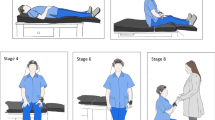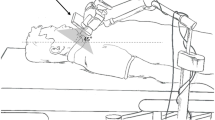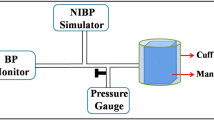Abstract
We assessed the capability of an integrated multisensory patch-type monitor (RootiRx®) in detecting episodes of reflex (pre)syncope induced by tilt table test (TTT). Firstly, we performed an intrapatient comparison of cuffless systolic blood pressure (SBP), R–R interval (RRI) and variability (power spectrum analysis) obtained by means of the RootiRx® with those obtained with conventional methods (CONV) with validated finger pressure devices at baseline in supine position and repeatedly during TTT in 32 patients affected by likely reflex syncope. Secondly, the LF/HF values obtained with RootiRx® during TTT were analyzed in 50 syncope patients. Compared with baseline supine recordings, during TTT a decrement of median SBP was observed with CONV (−53.5 mmHg) but not with RootiRx® ®(−1 mmHg). Conversely, RRI reduction (CONV: 102 ms; RootiRx®: 127 ms) and RRI Low Frequency/High Frequency powers ratio (LF/HF) increase (CONV: 1.6; RootiRx®: 2.5) were similar. The concordance was good for RRI (0.97 [95% CI 0.96–0.98]) and fair for LF/HF ratio (0.69 [95% CI 0.46-0.83]). During the first 5 min of TTT the LF/HF ratio was higher in patients who later developed syncope than in no-syncope patients. This ratio was significantly different among patients with syncope, presyncope or without symptoms at the time of syncope (p value = 0.02). In conclusion, cuffless RootiRx® was unable to detect rapid drops of SBP occurring during impending reflex syncope and thus cannot be used as a diagnostic tool for hypotensive syncope. On the other hand, RRI mean values and LF/HF power ratios obtained with RootiRx® were consistent with those simultaneously obtained using conventional methods.
This is a preview of subscription content, access via your institution
Access options
Subscribe to this journal
Receive 12 digital issues and online access to articles
$119.00 per year
only $9.92 per issue
Buy this article
- Purchase on Springer Link
- Instant access to full article PDF
Prices may be subject to local taxes which are calculated during checkout




Similar content being viewed by others
Data availability
The datasets generated during and/or analyzed during the current study are available upon reasonable request https://zenodo.org/badge/DOI/10.5281/zenodo.7793208.svg
References
Brignole M, Rivasi G. New insights in diagnostics and therapies in syncope: a novel approach to non-cardiac syncope. Heart. 2021;107:864–73.
Parati G, Saul JP, Di Rienzo M, Mancia G. Spectral analysis of blood pressure and heart rate variability in evaluating cardiovascular regulation. A critical appraisal. Hypertension. 1995;25:1276–786.
Brignole M, Moya A, de Lange FJ, Deharo JC, Elliott PM, Fanciulli A, et al. ESC Scientific Document Group. 2018 ESC guidelines for the diagnosis and management of syncope. Eur Heart J. 2018;39:1883–948.
Bartoletti A, Alboni P, Ammirati F, Brignole M, Del Rosso A, Foglia Manzillo G, et al. ‘The Italian Protocol’: a simplified head-up tilt testing potentiated with oral nitroglycerin to assess patients with unexplained syncope. Europace. 2000;2:339–42.
Scalise F, Margonato D, Sole A, Sorropago A, Sorropago G, Mancia G. Ambulatory blood pressure monitoring by a novel cuffless device: a pilot study. Blood Press. 2020;29:375–81.
Lomb NR. Least-squares frequency analysis of unequally spaced data. Astrophys Space Sci. 1976;39:447–62. https://doi.org/10.1007/BF00648343
Scargle J. Studies in astronomical time series analysis. II – statistical aspects of spectral analysis of unevenly spaced data. Astrophys Space J. 1983;263. https://doi.org/10.1086/160554.
Task Force of the European Society of Cardiology the North American Society of Pacing Electrophysiology. Heart rate variability: standards of measurement, physiological interpretation and clinical use. Circulation 1996;93:1043–65.
Castiglioni P, Di Rienzo M, On the evaluation of heart rate spectra: the Lomb periodogram. In: Computers in cardiology; 1996. p. 505–8. https://doi.org/10.1109/CIC.1996.542584
Castiglioni P. “Lomb periodogram” In: Encyclopedia of biostatistics, 2nd ed. Vol 4. Armitage P, Colton T, editors. John Wiley & Sons; 2005. p. 2905–6. isbn:0-470-84907-X
Sim I. Mobile devices and health. N Engl J Med. 2019;381:956–68.
Karaoğuz MR, Yurtseven E, Aslan G, Deliormanlı BG, Adıgüzel Ö, Gönen M, et al. The quality of ECG data acquisition, and diagnostic performance of a novel adhesive patch for ambulatory cardiac rhythm monitoring in arrhythmia detection. J Electrocardiol. 2019;54:28–35.
Imholz BPM, Van Montfrans GA, Settels JS, Van der Hoeven GMA, Karemaker JM, Wieling W. Continuous non-invasive blood pressure monitoring: reliability of Finapres device during the Valsalva manoeuvre. Cardiovasc Res. 1988;22:390–7.
Parati G, Ongaro G, Bilo G, Glavina F, Castiglioni P, Di Rienzo M, et al. Non-invasive beat-to-beat blood pressure monitoring: new developments. Blood Press Monit. 2003;8:31–6.
Thijs RD, Brignole M, Falup-Pecurariu C, Fanciulli A, Freeman R, Guaraldi P, et al. Recommendations for tilt table testing and other provocative cardiovascular autonomic tests in conditions that may cause transient loss of consciousness. Clin Auton Res. 2021;31:369–84.
Parati G, Casadei R, Groppelli A, Di Rienzo M, Mancia G. Comparison of finger and intra-arterial blood pressure monitoring at rest and during laboratory testing. Hypertension 1989;13:647–55. https://doi.org/10.1161/01.hyp.13.6.647.
Maggi R, Viscardi V, Furukawa T, Brignole M. Non-invasive continuous blood pressure monitoring of tachycardic episodes during interventional electrophysiology. Europace. 2010;12:1616–22.
Ilies C, Grudev G, Hedderich J, Renner J, Steinfath M, Bein B, et al. Comparison of a continuous noninvasive arterial pressure device with invasive measurements in cardiovascular postsurgical intensive care patients: A prospective observational study. Eur J Anaesthesiol. 2015;32:20–8.
Fortin J, Marte W, Grüllenberger R, Hacker A, Habenbacher W, Heller A, et al. Continuous non-invasive blood pressure monitoring using concentrically interlocking control loops. Comput Biol Med. 2006;36:941–57.
Pagani M, Lombardi F, Guzzetti S, Rimoldi O, Furlan R, Pizzinelli P, et al. Power spectral analysis of heart rate and arterial pressure variabilities as a marker of sympatho-vagal interaction in man and conscious dog. Circ Res. 1986;59:178–93.
Parati G, Di Rienzo M, Bertinieri G, Pomidossi G, Casadei R, Groppelli A, et al. Evaluation of the baroreceptor-heart rate reflex by 24-hour intra-arterial blood pressure monitoring in humans. Hypertension 1988;12:214–22.
Omboni S, Parati G, Frattola A, Mutti E, Di Rienzo M, Castiglioni P, et al. Spectral and sequence analysis of finger blood pressure variability. Comparison with analysis of intra-arterial recordings. Hypertension. 1993;22:26–33.
Furlan R, Porta A, Costa F, Tank J, Baker L, Schiavi R, et al. Oscillatory patterns in sympathetic neural discharge and cardiovascular variables during orthostatic stimulus. Circulation. 2000;101:886–92.
Carrasco JL, Phillips BR, Puig-Martinez J, King TS, Chinchilli VM. Estimation of the concordance correlation coefficient for repeated measures using SAS and R. Comput Methods Prog Biomed. 2013;109:293–304.
Parati GF, Torlasco C, Omboni S, Pellegrini D. Smartphone applications for hypertension management: a potential game-changer that needs more control. Curr Hypertens Rep. 2017;19:48.
Simjanoska M, Gjoreski M, Gams M, Madevska Bogdanova A. Non-Invasive blood pressure estimation from ecg using machine learning techniques. Sensors. 2018;18:1160 https://doi.org/10.3390/s18041160
Association for the Advancement of Medical Instrumentation. American National Standard: non-invasive sphygmomanometers – part 2: clinical validation of automated measurement type; ANSI/AAMI/ISO. 2013; 81060-2. http://my.aami.org/store/detail.aspx?xml:id=8106002
Rivasi G, Groppelli A, Brignole M, Soranna D, Zambon A, Bilo G, et al. Association between hypotension during 24 h ambulatory blood pressure monitoring and reflex syncope: the SynABPM 1 study. Eur Heart J. 2022;43:3765–76.
Lung SC, Chen N, Hwang JS, Hu SC, Wang WV, Wen TJ, et al. Panel study using novel sensing devices to assess associations of PM2.5 with heart rate variability and exposure sources. J Expo Sci Environ Epidemiol. 2020;30:937–48.
Kochiadakis GE, Orfanakis A, Chryssostomakis SI, Manios EG, Kounali DK, Vardas PE. Autonomic nervous system activity during tilt testing in syncopal patients, estimated by power spectral analysis of heart rate variability. Pacing and clinical electrophysiology. PACE. 1997;20:1332–41.
Kochiadakis GE, Kanoupakis EM, Igoumenidis NE, Marketou ME, Solomou MC, Vardas PE. Spectral analysis of heart rate variability during tilt-table testing in patients with vasovagal syncope. Int J Cardiol. 1998;64:185–94.
Boulos M, Barron S, Nicolski E, Markiewicz W. Power spectral analysis of heart rate variability during upright tilt test: a comparison of patients with syncope and normal subjects. Cardiology. 1996;87:28–32.
Kouakam C, Lacroix D, Zghal N, Logier R, Klug D, Le Franc P, et al. Inadequate sympathovagal balance in response to orthostatism in patients with unexplained syncope and a positive head up tilt test. Heart (Br Card Soc). 1999;82:312–8.
Lipsitz LA, Mietus J, Moody G, Goldberger A. Spectral characteristics of heart rate variability before and during postural tilt relations to aging and risk of syncope. Circulation. 1990;81:1803–10.
Funding
Research partially funded by the Italian Ministry of Health.
Author information
Authors and Affiliations
Contributions
MB, GFP and AU designed the study and wrote the text. AG and MR designed the CRF and the database, recruited the patients, and acquired the data. GDT, SA, and GR recruited the patients, and acquired the data. EC, DS, AZ, and PC performed statistical analysis and methodology of the study. All authors contributed to the discussion of results and to the revision of the text.
Corresponding author
Ethics declarations
Competing interests
The authors declare no competing interests.
Additional information
Publisher’s note Springer Nature remains neutral with regard to jurisdictional claims in published maps and institutional affiliations.
Supplementary information
Rights and permissions
Springer Nature or its licensor (e.g. a society or other partner) holds exclusive rights to this article under a publishing agreement with the author(s) or other rightsholder(s); author self-archiving of the accepted manuscript version of this article is solely governed by the terms of such publishing agreement and applicable law.
About this article
Cite this article
Groppelli, A., Rafanelli, M., Testa, G.D. et al. Detection of impending reflex syncope by means of an integrated multisensor patch-type recorder. J Hum Hypertens 37, 1098–1104 (2023). https://doi.org/10.1038/s41371-023-00840-y
Received:
Revised:
Accepted:
Published:
Issue Date:
DOI: https://doi.org/10.1038/s41371-023-00840-y



